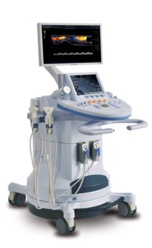Aixplorer Ultrasound System
Technology description

The Aixplorer system is based on a technique called Shear Wave Elastography, which uses the fact that the propagation speed of shear waves in tissues is related to the stiffness of the material. Therefore, by generating shear waves in the tissue and measuring their speed, it is possible to derive the stiffness of the tissue. In order to generate the shear wave, the ultrasound beam is electronically focused at different locations in the tissue, producing several acoustic pushes. The coherent sum of these perturbations will result is a shear wave propagating within the tissue. The propagation of the shear wave is recorded by ultrafast ultrasound imaging (frame rate up to 15 kHz) and tracked by a Doppler technique. Finally, the elastic modulus of the tissue (stiffness) is derived using a suitable propagation model.
Clinical impact
Elastography can be applied to a large number of clinical applications, since changes in tissue stiffness is a sign of abnormalities in many organs. The technique has therefore great potential to significantly improve future healthcare and consequentially reduce costs for diagnosis and interventions.
Shear wave elastography has the potential, for example, to:
- become an alternative to mammography for breast cancer detection
- improve arterial plaque characterization and reduce risk for stroke
- detect cervix tumors and assess cervix stiffness to prevent premature birth
- aid diagnosis of liver fibrosis
- improve diagnostics of tendon and skeletal muscle diseases and injuries
